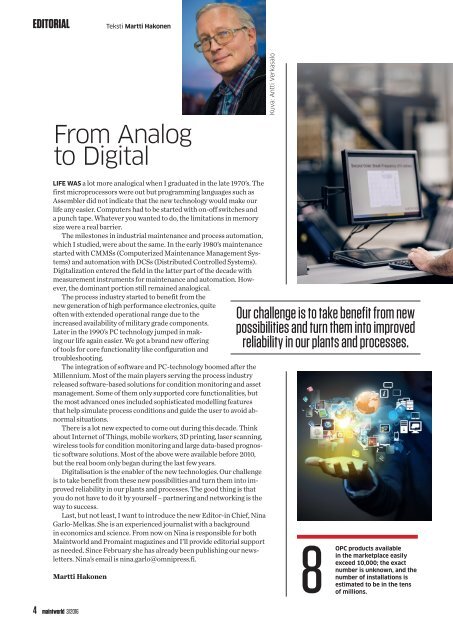Maintworld Issue3 2016
Create successful ePaper yourself
Turn your PDF publications into a flip-book with our unique Google optimized e-Paper software.
EDITORIAL<br />
Teksti Martti Hakonen<br />
From Analog<br />
to Digital<br />
Kuva: Antti Verkasalo<br />
LIFE WAS a lot more analogical when I graduated in the late 1970’s. The<br />
first microprocessors were out but programming languages such as<br />
Assembler did not indicate that the new technology would make our<br />
life any easier. Computers had to be started with on-off switches and<br />
a punch tape. Whatever you wanted to do, the limitations in memory<br />
size were a real barrier.<br />
The milestones in industrial maintenance and process automation,<br />
which I studied, were about the same. In the early 1980’s maintenance<br />
started with CMMSs (Computerized Maintenance Management Systems)<br />
and automation with DCSs (Distributed Controlled Systems).<br />
Digitalization entered the field in the latter part of the decade with<br />
measurement instruments for maintenance and automation. However,<br />
the dominant portion still remained analogical.<br />
The process industry started to benefit from the<br />
new generation of high performance electronics, quite<br />
often with extended operational range due to the<br />
increased availability of military grade components.<br />
Later in the 1990’s PC technology jumped in making<br />
our life again easier. We got a brand new offering<br />
of tools for core functionality like configuration and<br />
troubleshooting.<br />
The integration of software and PC-technology boomed after the<br />
Millennium. Most of the main players serving the process industry<br />
released software-based solutions for condition monitoring and asset<br />
management. Some of them only supported core functionalities, but<br />
the most advanced ones included sophisticated modelling features<br />
that help simulate process conditions and guide the user to avoid abnormal<br />
situations.<br />
There is a lot new expected to come out during this decade. Think<br />
about Internet of Things, mobile workers, 3D printing, laser scanning,<br />
wireless tools for condition monitoring and large data-based prognostic<br />
software solutions. Most of the above were available before 2010,<br />
but the real boom only began during the last few years.<br />
Digitalisation is the enabler of the new technologies. Our challenge<br />
is to take benefit from these new possibilities and turn them into improved<br />
reliability in our plants and processes. The good thing is that<br />
you do not have to do it by yourself – partnering and networking is the<br />
way to success.<br />
Last, but not least, I want to introduce the new Editor-in Chief, Nina<br />
Garlo-Melkas. She is an experienced journalist with a background<br />
in economics and science. From now on Nina is responsible for both<br />
<strong>Maintworld</strong> and Promaint magazines and I’ll provide editorial support<br />
as needed. Since February she has already been publishing our newsletters.<br />
Nina’s email is nina.garlo@omnipress.fi.<br />
Martti Hakonen<br />
4 maintworld 3/<strong>2016</strong><br />
Our challenge is to take benefit from new<br />
possibilities and turn them into improved<br />
reliability in our plants and processes.<br />
8<br />
OPC<br />
products available<br />
in the marketplace easily<br />
exceed 10,000; the exact<br />
number is unknown, and the<br />
number of installations is<br />
estimated to be in the tens<br />
of millions.

















